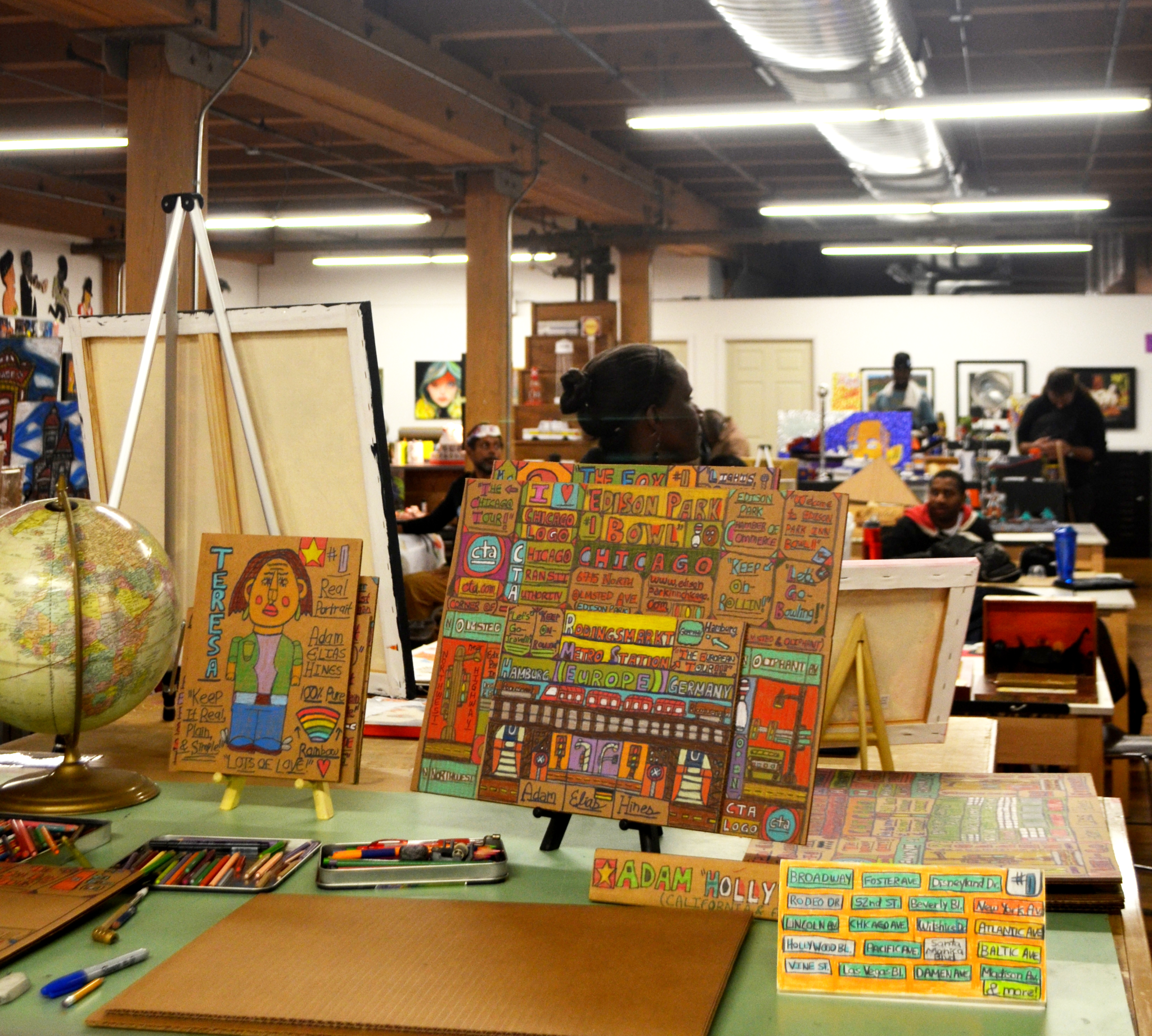Although Project Onward had already opened their studio doors for a public celebration and viewing, many of the artists present were still hard at work. The evening reception was the second part of a four-day, multi-artist exhibit, “When I Paint My Masterpiece,” which highlighted the creations and techniques of artists with disabilities from across Chicago.
One artist, Adam Hines, put down his pencil, and held out a passing fist bump to Project Onward’s photographer for the evening, Mike Pocius. “It’s time to rock and roll for the second time,” Hines said with relish, swiveling back around in his chair before absorbing himself in a new sketch.
Pocius volunteered to show me around the building and introduce me to a few of its more than fifty artists. A nonprofit, community-engaged space on the fourth floor of the Bridgeport Art Center, Project Onward unites workstations and private ateliers under the same roof with an adjacent white-cube gallery for displays and art sales; its physical layout makes possible a joint showcase of artists’ creative processes and their finished products.
Project Onward has only been in the building for the past three years. I had a chance to talk to one of its newer artists, Sheila Smith, about her paintings. Smith came to Project Onward in 2014 and had high praise for the relationships that sprung up between the artists.
“It’s a very friendly and safe atmosphere. A person just comes over and is like: ‘Sheila, I like your painting!’ ”
Two of Smith’s canvasses—“Black and White Gears” and “Out of the Box”—were hung across from each other, almost as comparative pendant pieces. Smith said that the monochrome “Gears” was an experiment she’d undertaken at a previous suggestion; she normally prefers the bright, vibrant colors on display in “Box.” Both of the works are meticulously slick and smooth. Smith leverages the plasticky properties of the acrylic paint, obliterating facture and other traces of brushwork—creating uniform, geometric bodies or seamlessly melted confluences of color.
In the case of “Gears,” the handling is so smooth that the paint reveals the weave and nap of the canvas. Her black and white painting confuses figure and background in a way that her colored works do not. Their vibrant hues clearly indicate what she’s added to the canvas as a painter and that legibility is swallowed up when she takes the colors away, working outside her preferred mode.
The sheer dedication of the artists strikes you when you first walk in. The different desks and easels stretch deep into the open floor plan. Flat file storage for works on paper line the back partitions. More work happens behind the closed doors. Finished canvasses hang salon-style wherever there’s space on the walls. Hines, for example, joked that he’d completed over 10,000 drawings since joining the group; the immense portfolio he had out that night suggested that he wasn’t altogether kidding.
When I asked Pocius how often the artists came in, he turned to one artist packing up for the night: Four days a week, if doctors’ appointments didn’t throw him off. The next artist, Motesem Mansur, admitted to working 11am to 5pm every Friday. He was currently finishing up an exacting study of the iconic Chicago Theatre sign, at least fifteen or twenty in number, at varying angles and sizes.
Mansur was recruited after a stretch of time at the downtown Chicago Cultural Center, designing greeting cards and architectural sketches popular with tourists. He credited a lot of help and inspiration to another Project Onward artist, Andrew Hall. When Mansur came in, most of his figural experience was from working on copy paper, in ballpoint pen. “Andrew encouraged me to use professional materials, encouraged me to look at perspective and look at colors the right way.”
Mansur was especially appreciative of the creative community he had grown over time. His praise extended to Project Onward’s many volunteers. He’d come to work in the morning and find a volunteer had already laid out a soda for him from the kitchenette—a simple but helpful and heartfelt gesture.
Talking with different artists, collectivity turned out to be a big theme, an essential influence on their creative strategies. Each person I met could instantly hook their thumb in the direction of a friend’s chair or single out a specific head in the crowd. Project Onward’s executive director, Rob Lentz, chalked up the formation of this professional society as one of the organization’s big successes. “Our space is a communal studio,” Lentz underscored. “Socially, it’s a huge benefit. Most of these guys are self-taught, which means they’ve done this alone.”
In bringing these artists together, the space remedies a key challenge for adults with disabilities—isolation. Lentz explained that the robust support systems offered by elementary and high schools don’t always extend later into life. The trope of the lone bohemian painter is, in this case, worsened by shortcomings in larger social structures.
Project Onward thus provides the framework and—as much as funding permits—the materials for great art to happen. Advocates more than educators, Lenz argued that Project Onward only really attends to the logistical side of creativity.
“These guys are pros and they know what they are doing,” said Lenz. “The best thing we can do is get out of their way.”
It’s tempting to read the exhibition’s title, “When I Paint My Masterpiece,” as an open-ended statement. Project Onward’s ethos defers the definitive magnum opus that would cap an artist’s career. The willingness of its artists to actively experiment and abundantly create flows from the community-building that the nonprofit enables. The togetherness they cultivate drives a kind of aesthetic fearlessness—a spirit confirmed in the fantastic number and variety of objects the studio’s artists make. Project Onward lets artists cultivate a vital, evolving practice, enhancing the daily lives of artists with disabilities while encouraging them to create ever greater work.



Great article on Project Onward!